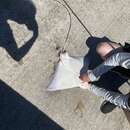Diagnostic Description
provided by Fishbase
Disk broad with long sharply pointed wings and projecting snout. Tail very long, Few middorsal spines on disk in adults (Ref. 7251). Greyish, reddish chocolate or dusky brown above. Lower surface either pure white or whitish. Teeth green (Ref. 6902).
- Recorder
- Arlene G. Sampang-Reyes
Life Cycle
provided by Fishbase
Exhibit ovoviparity (aplacental viviparity), with embryos feeding initially on yolk, then receiving additional nourishment from the mother by indirect absorption of uterine fluid enriched with mucus, fat or protein through specialised structures (Ref. 50449).
Trophic Strategy
provided by Fishbase
Found frequently in coastal waters to 10 m depth, mainly in shallow estuaries. Capable of travelling long distances, occasionally leaps out of the water. Swims in midwater. Cruises slowly over the bottom, rooting out bivalves with its beak and wings when feeding.
- Recorder
- Drina Sta. Iglesia
Biology
provided by Fishbase
Found frequently in coastal waters to 10 m depth, mainly in shallow estuaries. Capable of traveling long distances, occasionally leaps out of the water. Swims in midwater. Cruises slowly over the bottom, rooting out bivalves with its beak and wings when feeding (Ref. 7251). Ovoviviparous (Ref. 50449).
Importance
provided by Fishbase
fisheries: minor commercial; price category: medium; price reliability: very questionable: based on ex-vessel price for species in this family
Bullnose ray
provided by wikipedia EN
The bullnose ray (Myliobatis freminvillii) is an eagle ray, which is widely distributed in the western Atlantic. It is found at depth above 10 m (33 ft) in coastal waters from Cape Cod down to Argentina, but is absent from parts of the western central Atlantic. It reaches a maximum size of 106 cm (42 in) in disc width and gives birth to six young per litter. It is often confused with the southern eagle ray (M. goodei).[1] The bullnose ray feeds mostly hermit crabs, gastropods, and bivalves.
References
-
^ a b Carlson, J., Charvet, P., Avalos, C., Blanco-Parra, MP, Briones Bell-lloch, A., Cardenosa, D., Chiaramonte, G.E., Cuevas, J.M., Derrick, D., Espinoza, E., Mejía-Falla, P.A., Morales-Saldaña, J.M., Motta, F., Naranjo-Elizondo, B., Pacoureau, N., Paesch, L., Pérez Jiménez, J.C., Rincon, G., Schneider, E.V.C., Simpson, N.J., Talwar, B.S. & Pollom, R. "Myliobatis freminvillii (Bullnose Ray)". IUCN Red List of Threatened Species.
{{cite journal}}: CS1 maint: multiple names: authors list (link)
Springer Link

- license
- cc-by-sa-3.0
- copyright
- Wikipedia authors and editors
Bullnose ray: Brief Summary
provided by wikipedia EN
The bullnose ray (Myliobatis freminvillii) is an eagle ray, which is widely distributed in the western Atlantic. It is found at depth above 10 m (33 ft) in coastal waters from Cape Cod down to Argentina, but is absent from parts of the western central Atlantic. It reaches a maximum size of 106 cm (42 in) in disc width and gives birth to six young per litter. It is often confused with the southern eagle ray (M. goodei). The bullnose ray feeds mostly hermit crabs, gastropods, and bivalves.

Jaws
- license
- cc-by-sa-3.0
- copyright
- Wikipedia authors and editors


 Jaws
Jaws